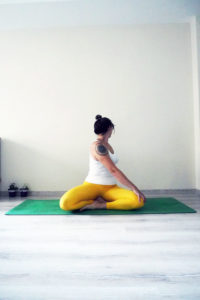Yoga twists are good in so many ways! I love to do them as part of my regular yoga practice as a warm up or a cool down, and within a yoga flow. Read on to learn what a yoga twist is, the benefits of a yoga twist, and how to do a simple yoga twist at home on your own.

What is a yoga twist?
A yoga twist targets the upper, middle and lower parts of the spine, and can help with back pain and increase flow of energy. Yoga twists can be done while sitting, standing, or lying on the ground.
What are the physical benefits of a yoga twist?
- First of all, yoga twists gently rotate the spine, which helps improve the spinal cord’s range of motion. As a bonus, they give a good stretch to the back muscles.
- Second of all, yoga twists help lengthen the spine and can help improve spinal nerve health by decompressing the vertebral space. Viola! Your flow of energy increases in a gentle way.
- In addition, yoga twists help aid digestion. They work on the abdominal muscles, stimulating blood circulation, and releasing tension. This increases blood flow that is rich in nutrients and oxygen.
- Last but not least, yoga twists can help correct bad posture from slouching or sitting for many hours at a desk or in a car. Twists help strengthen the back muscles and provide pain relief.
How to do this simple yoga twist at home
This yoga twist is a variation of Easy Pose, called “Sukhasana” in Sanskrit, which is a basic seated yoga posture. The Sanskrit name, Parivrtta Sukhasana — (PAH-ruh-VREE-tah soo-KAHS-uh-nuh) — comes from three words:
- Parivrtta — turn around/revolve
- Sukha — easy/comfortable/joy from su — good, and kha — space
- Asana — pose
Now, let’s try Parivrtta Sukhasana!

- Sit comfortably on the ground with your shoulders relaxed, chin centered, and back as straight as possible. This helps support your neck and your spine. You can place a blanket or yoga block under your knees for support. Balance your weight evenly across your sit bones. If your hips are tight, you can sit on your knees, but be careful not to put too much pressure on your knees.
- Place your right hand on your left knee, and your left hand (or fingertips of your left hand) on the ground behind you for support. You can also place a yoga block directly behind you and place your palm or fingertips on it to elevate and ensure your shoulders are even as you twist.

- Take a deep breath in, filling your chest with air, and as you exhale, gently twist towards the left while looking over your left-hand shoulder.
- Breathe in and out for 3-5 breaths
- As you exhale, come back to center and walk your left hand to your right knee and place your right hand behind you.

- Take a deep breath in, filling your chest with air, and as you exhale, gently twist towards the right while looking over your right-hand shoulder.
- Breathe in and out for 3-5 breaths
- To release the pose, as you exhale, come back to center, and smile! You’ve done a yoga twist.

Yoga posts are informational. If you have any medical concerns, talk with your doctor before practicing yoga. Avoid practicing Parivrtta Sukhasana if you have a knee injury. In particular, avoid twists if you have a spinal disc injury, chronic digestive problems, severe inflammatory conditions of the abdomen, or Sacroiliac (SI) joint dysfunction.
Want to learn more about yoga and wellness? Check out more posts:
6 Ways Using a Bolster in Yoga Increases Health
5 Best Practices for Beginning a Yoga Routine
Rose Margaret Deniz is an artist, writer, and yoga instructor @roselayoga. The farm-girl turned expat has been gluten-free for over 12 years, and can be found in her kitchen whipping up seasonal meals for her bilingual family, growing herbs in her garden, painting and writing in her studio, and practicing yoga.




